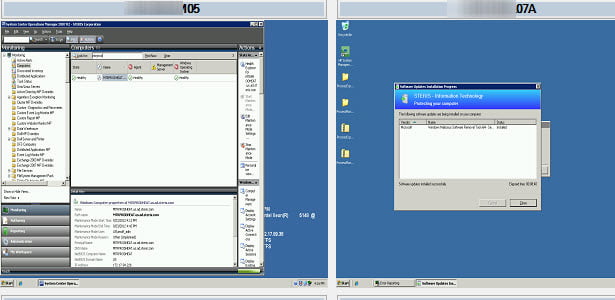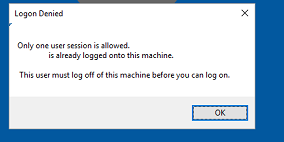- Multiple Remote Users Windows 10 Home
- Windows 10 Enterprise Multiple Remote Users
- Allow Multiple Users Windows 10 Remote
- Allow Multiple Remote Desktop Connections
I am a statistics teacher.I am setting up a powerful PC at home so my five students can remotely access the stats software on it.
This is a limitation with Remote Desktop running a client workstation like Windows 10. Remote desktop is just a single desktop not multiple desktops. IF you want this capability you have to use Remote desktop services but that requires Windows Server and and not Windows 10 but that's pretty extreme. Multiple RDP (Remote Desktop) sessions in Windows 10 Option 1 - Modifying termsrv.dll To have concurrent user sessions working in Windows 10, you need to make small changes to termsrv.dll file.
I have looked at a few possible remote access possibilities, but none seem to meet the following simple requirements for less than $50 a month.
Each user logs in to their own account
They can upload files to their account
Multiple users can be logged in concurrently.
Can someone suggest the best way to achieve these requirements on a limited budget?
Ramhound1 Answer
This is impossible with an Windows workstation edition OS.
A Windows workstation OS (such as Windows 10) has two accessible 'interfaces':
Multiple Remote Users Windows 10 Home
- Console, which is accessible via the physical machine's interface and via most remote access programs such as VNC, LogMeIn, etc.
- Remote Desktop interface, which is accessible through the Windows RDP interface.
These two interfaces are the only consoles exposed by a workstation edition of Windows. The EULA (license agreement between a licensee of Windows and Microsoft) prohibits more than a single licensed user from accessing these interfaces at any one time. This is enforced by the fact access to one of the two consoles forces the other to disconnect.
Bottom line: You cannot do this with a workstation edition of Windows.
In the Windows OS world, what you're trying to accomplish requires a Windows Server OS with the Remote Desktop Session Host role installed and the requisite RDSH Client Access Licenses (CALs). These are somewhat costly...unless you're eligible for Microsoft's Non-Profit (Charity) licensing program, which offers such software at <25% retail in some cases. Check with your Microsoft license provider for details.
Twisty Impersonator Twisty Impersonator
Twisty Impersonator
Not the answer you're looking for? Browse other questions tagged remote-access or ask your own question.
Video: Microsoft warns of remote code execution flaw that affects CredSSP
Microsoft officials hinted earlier this year that they were working on new ways to deliver virtual desktop/app capabilities in Windows 10 that they'd make available later this year. Word is starting to trickle out about what might be in the works.
Remote Desktop Services (RDS) currently is a Windows Server role that allows users to interact with apps hosted on servers, not on their PCs. Many companies use this approach to provide app-access to firstline/frontline workers, as well for certain remote-working situations.
Last year, Microsoft officials said they were working on a 'Modern' refresh of RDS, as outlined in a February 2018 Directons on Microsoft Report entitled 'Updates Coming to Remote Desktop Services' (accessible to members only).
'Remote Desktop Modern Infrastructure (RDmi), planned for general availability in late 2018, will bring changes to RDS that could make it more attractive to host the service in Azure, in addition to offering improvements to security and other benefits,' said the Directions on Microsoft report.
Windows 10 Enterprise Multiple Remote Users
At the moment, Microsoft's roadmap about the changes coming to RDS is currently incomplete, Directions on Microsoft noted. Beyond saying new RDS capabilities will be available in the Semi-Annual Channel version (aka Redstone 5/1809) in some way, Microsoft has yet to share specifics.
Some of my contacts recently mentioned a new 'multi-session' feature that's likely to be introduced around October 2018 as part of Windows 10 'Redstone 5'/1809. In the past couple of weeks, I've started seeing references around the web about the possible existence of such a feature. This is functionality for which a number of IT Pros have been asking for some time.
Allow Multiple Users Windows 10 Remote
Last week, with Microsoft's delivery of a first preview of Windows Server 2019, speculation about how Microsoft will deliver Remote Desktop Services began percolating again. Brian Madden, the creator of BrianMadden.com, verified that the RDSH (Remote Desktop Session Host) role cannot be installed on Windows Server 2019.
Madden blogged that he also had heard rumors of Microsoft adding a multi-user, multi-windowing based option to Windows 10.
Allow Multiple Remote Desktop Connections
'In other words, Microsoft is taking Terminal Server out of Windows Server and moving (it) into Windows 10,' he wrote. 'If true, this is fantastic.'
My contacts are saying Microsoft will offer multiple options to provide remote desktop/app access. Individual Windows 10 Enterprise users will continue to have the option to run a single Windows 10 desktop virtually. Additionally, customers who want to make apps available remotely to a small number of users will be able to go with Windows 10 Multi Session, rather than having to rely on Windows Server, I'm hearing.
The new Windows 10 Multi Session capability is expected to work with both Win32 and Universal Windows Platform apps and work with Microsoft's Edge browser, my contacts have said.
I'm expecting the new multi-session feature to be at least part of Microsoft's solution for supporting Office apps via Office 365 Pro Plus. Microsoft officials said earlier this year they would share more information regarding new virtualization capabilities for customers who use Remote Desktop and VDI/desktop virtualization to run Office apps.
I don't know how Microsoft is planning to price or license the new Windows 10 multi-session functionality. I asked the company for comment and was told by a spokesperson Microsoft had nothing to share on the topic.
Windows 10
